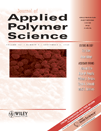The rheological behavior of EPDM Nordel IP and POE engage produced by CGC and INSITE™ technology
Abstract
The rheological behavior of EPDM Nordel and POE Engage produced by CGC and INSITE™ technology are studied with double capillary rheometer of constant speed type. It is indicated that the melt viscosity of EPDM Nordel IP 3745P is higher and the nonlinear fluidity is stronger compared with Nordel IP 3722P, because the molecular weight of Nordel IP 3745P is higher and the MWD is narrow. We compare the melt viscosity of POE Engage GPE8003 with that of Engage GPE8150, and indicate that the influence of temperature on viscosity of Engage GPE8003 is obvious and the influence of shear rate on viscosity of Engage GPE8150 is stronger, which was related to the octene percent in material. The melt slide at wall and the extrusion pressure vibration occurred with EPDM Nordel IP 3745P. © 2006 Wiley Periodicals, Inc. J Appl Polym Sci 101: 2847–2853, 2006




